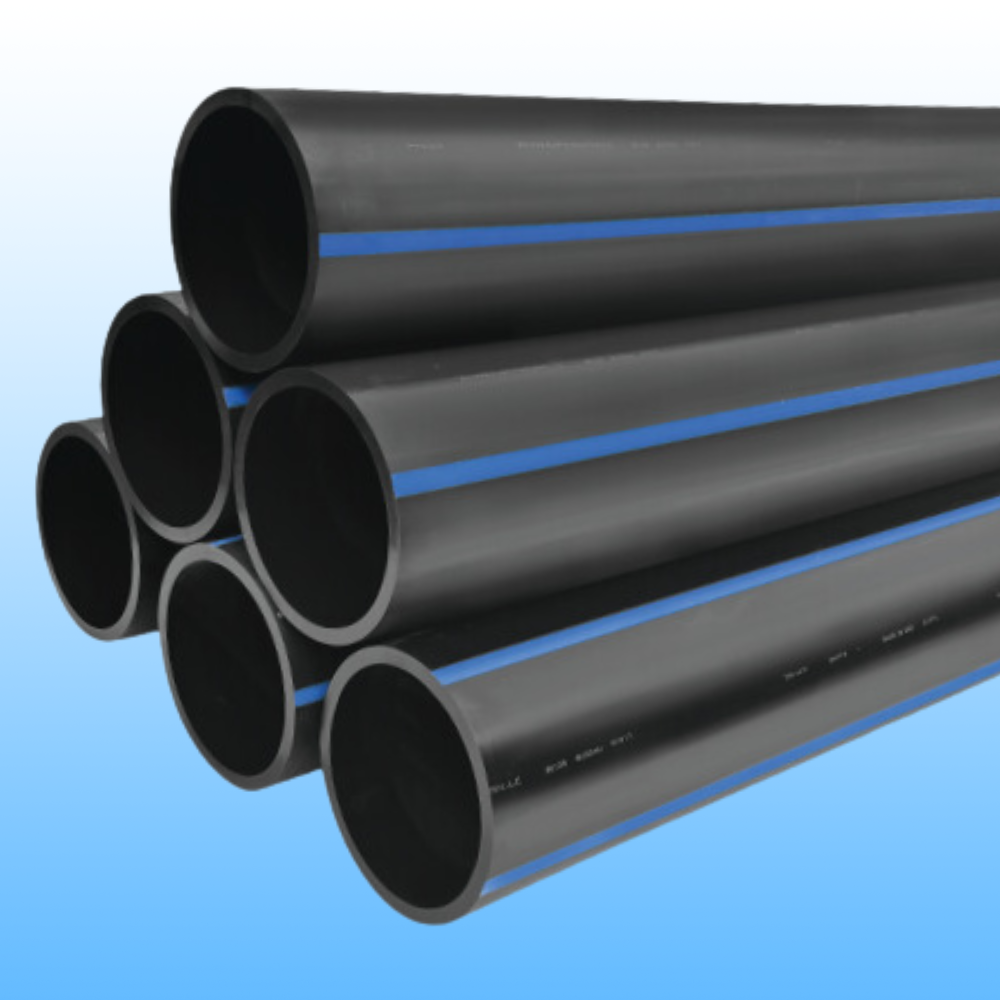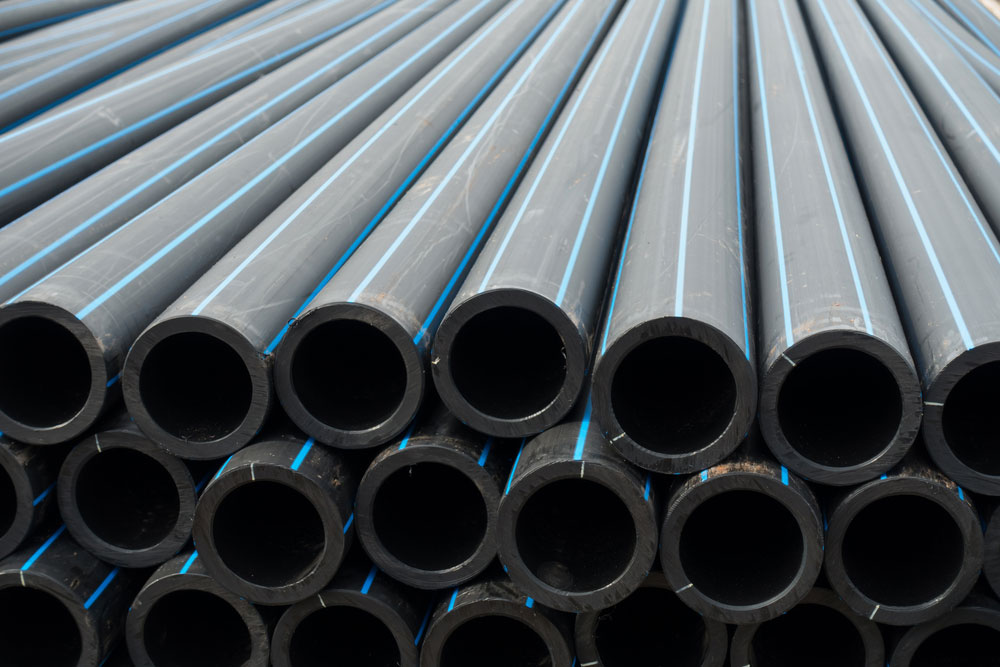American Plastics HDPE Pipe for Oilfield: Preferred in the Oilfield
Wiki Article
Check Out the Manufacturing Process Behind High-Quality HDPE Pipeline and Its Applications
The manufacturing procedure of top notch HDPE pipes is elaborate and systematic. It starts with the option of raw materials that enhance performance. Following this, ethylene undergoes polymerization to create resin, which is then shaped with extrusion. Quality control is paramount, ensuring that the end product satisfies rigid standards. Nonetheless, the trip of HDPE pipelines does not end with production. Their applications across various sectors reveal a more comprehensive relevance worth examining.Understanding HDPE: Properties and Advantages

High-density polyethylene (HDPE) is a versatile thermoplastic understood for its resilience and resistance to different ecological aspects. This material exhibits exceptional tensile strength, making it appropriate for requiring applications. Its low-density framework adds to a light-weight item, facilitating ease of dealing with and installment. HDPE likewise showcases impressive resistance to chemicals, which minimizes destruction when subjected to extreme substances.
The product's reduced wetness absorption additionally improves its long life, making it optimal for usage in pipes and tank. Furthermore, HDPE is immune to ultraviolet (UV) radiation, guaranteeing that products keep their honesty also when subjected to sunlight. Its versatility enables for the creation of complex forms without compromising stamina. The environment-friendly nature of HDPE, typically stemmed from recycled materials, includes in its appeal, advertising lasting methods in production. On the whole, these residential properties and advantages make HDPE a favored choice for different industrial and consumer applications.
Basic Material Choice for HDPE Production
The option of basic materials for HDPE production is important to validate the end product meets the desired requirements and quality criteria. High-density polyethylene (HDPE) is largely created from polymerized ethylene, stemmed from nonrenewable fuel sources such as all-natural gas or crude oil. The quality of these feedstocks substantially affects the mechanical and thermal properties of the last HDPE.Additives additionally play a considerable duty in enhancing HDPE's performance, including antioxidants, UV stabilizers, and colorants, which enhance sturdiness and resistance to ecological elements. The option procedure must think about not just the chemical make-up of the raw products however additionally their handling features to ensure effective production.
The sourcing of raw materials need to prioritize sustainability and compliance with environmental guidelines, as liable methods are necessary in today's market. Ultimately, mindful raw product selection lays the foundation for generating top quality HDPE pipes ideal for diverse applications.
The Extrusion Process: Forming HDPE Pipeline
The extrusion process plays an important function fit HDPE pipes, beginning with thorough product preparation methods that ensure optimal circulation and uniformity. Equally essential is the design of the die, which straight affects the final measurements and surface area high quality of the pipe. Together, these aspects contribute considerably to the performance and high quality of HDPE pipe manufacturing.Material Preparation Methods
Efficient manufacturing of HDPE pipelines starts with meticulous material prep work methods, particularly the extrusion process. During this stage, high-density polyethylene material is very first dried out to remove wetness, making certain optimal flow characteristics. The resin is then fed right into the extruder, where it goes through heating and melting, changing into a viscous state. This heating process is very carefully regulated to preserve the material's stability and performance. The molten HDPE is required with a die, forming it into a continuous pipe form. Proper temperature management during extrusion is crucial, as it directly influences the material's buildings and the end product quality. Once formed, the HDPE pipe is cooled and reduced to defined lengths, ready for succeeding handling and applications.Die Style Value
Precision in die style plays an essential role in the extrusion process of HDPE pipelines. The die serves as the last shaping tool, straight influencing the pipe's measurements, wall thickness, and surface finish. A properly designed die assurances consistent product flow, minimizing defects such as irregularities and weak places. The geometry of the die should be optimized to fit the particular residential properties of HDPE, including its viscosity and thermal actions during extrusion. Furthermore, the cooling price of the product as it passes with the die can significantly impact the pipeline's architectural honesty. Spending in innovative die innovation is crucial for makers aiming to produce premium HDPE pipes that fulfill sector requirements and consumer assumptions.High Quality Control Measures in HDPE Production
Numerous elements affect the quality of HDPE pipeline manufacturing, effective high quality control procedures are crucial to guarantee uniformity and integrity in the final item (hdpe pipe fittings Midland TX). Key quality control methods consist of strenuous material assessment, verifying that the raw polyethylene fulfills established requirements for pureness and thickness. Throughout the extrusion procedure, parameters such as temperature, pressure, and cooling time are closely monitored to keep dimensional precision and architectural stabilityIn addition, post-production testing is necessary; manufacturers usually carry out hydrostatic tests to analyze the pipeline's strength and resistance to pressure. Visual evaluations for surface area issues better boost high quality assurance. Accreditation from pertinent criteria companies, like ASTM or ISO, provides an extra layer of credibility. By carrying out these detailed quality control measures, suppliers can reduce flaws, boost efficiency, and make sure that the HDPE pipes fulfill the specific needs of different applications, inevitably causing client complete satisfaction and rely on the item.
Applications of HDPE Pipe Throughout Industries
HDPE pipes are made use of throughout different industries due to their toughness and convenience. In water circulation systems, they assure effective delivery, while in wastewater administration, they supply trusted solutions for waste transportation. In addition, farming irrigation networks take advantage of HDPE's resistance to rust and flexibility, making it an ideal selection for modern farming methods.
Water Distribution Solutions
A significant variety of markets count on high-density polyethylene (HDPE) pipes for efficient water circulation systems. Known for their longevity and resistance to rust, HDPE pipes are commonly used in local supply of water networks, agricultural irrigation, and commercial applications. Their lightweight nature helps with simple handling and setup, reducing labor prices and time. Furthermore, HDPE pipelines can accommodate various pressure levels, making them suitable for both low and high-pressure systems. Pipe Manufacturing Midland TX. The versatility of the product permits seamless assimilation right into existing facilities, minimizing the requirement for substantial excavation. HDPE's resistance to chemical leaching assurances that the water delivered continues to be safe and tidy, making it an excellent selection for keeping the quality of safe and clean water across different industries.Wastewater Management Solutions
Effective water circulation systems additionally lead the way for innovative wastewater management solutions, where high-density polyethylene (HDPE) pipelines play a substantial role. Renowned for their resilience and resistance to deterioration, HDPE pipelines are suitable for transferring wastewater in different settings. Their versatility allows for very easy setup in complicated atmospheres, lessening the requirement for extensive excavation. In addition, HDPE's smooth indoor surface reduces friction, enhancing flow prices and performance. These pipes are likewise resistant to chemical leaching, making certain that contaminants do not endanger the surrounding setting. Industries, districts, and treatment facilities increasingly rely upon HDPE pipelines for their reliability and long life, making them a favored choice for modern-day wastewater monitoring systems. This versatility underscores the essential value of HDPE pipelines across many applications.Agricultural Irrigation Networks
Agricultural watering networks profit substantially from the usage of high-density polyethylene (HDPE) pipes, which give effective and trusted water delivery to crops. HDPE pipes are lightweight, making them easy to carry and set up, while their adaptability permits different setups in varied surfaces. These pipelines show excellent resistance to rust, chemicals, and UV radiation, guaranteeing sturdiness in harsh farming atmospheres. In addition, their smooth indoor surface reduces rubbing loss, maximizing water flow and lowering power costs connected with pumping. The long life of HDPE pipelines, commonly exceeding 50 years, adds to reduce upkeep and substitute expenses. Subsequently, farmers increasingly count on HDPE pipes to boost irrigation effectiveness and advertise lasting farming techniques, eventually causing boosted crop yields and resource conservation.Future Fads in HDPE Pipe Technology
As the demand for lasting hdpe pipe fittings Midland TX and efficient infrastructure grows, improvements in HDPE pipe innovation are poised to transform various markets. Emerging fads include the assimilation of clever modern technologies, such as sensing units and IoT capacities, which facilitate real-time tracking of pipeline conditions, lowering maintenance prices and preventing leakages. In addition, the development of innovative production techniques, such as 3D printing, is making it possible for the manufacturing of facility, customized pipe styles that satisfy particular project demands.Moreover, the concentrate on recycling and round economic climate practices is driving the technology of HDPE pipes made from recycled products, improving sustainability. Enhanced jointing methods, such as electro-fusion and mechanical fittings, are likewise improving installment performance and reliability. The expanding focus on environmental regulations is pushing makers to take on greener manufacturing processes, making sure that HDPE pipelines not only meet industry standards however likewise foster an even more sustainable future for infrastructure growth.
Often Asked Questions
Just How Does HDPE Contrast to Other Plastic Materials?
HDPE outmatches lots of other plastic materials regarding longevity, chemical resistance, and adaptability. Its reduced thickness and high tensile toughness make it excellent for numerous applications, usually exceeding alternatives in both performance and longevity.What Are the Ecological Influences of HDPE Manufacturing?
The environmental impacts of HDPE manufacturing include greenhouse gas exhausts, power consumption, and prospective contamination from manufacturing processes. Additionally, inappropriate disposal can cause soil and water contamination, elevating problems about long-lasting environmental results.Can HDPE Water Lines Be Recycled?
Yes, HDPE pipes can be recycled. Lots of facilities approve made use of HDPE for processing, transforming it right into new products. This reusing adds to sustainability efforts, decreasing plastic waste while conserving sources and energy in the production cycle.What Is the Life-span of HDPE Water Lines?

How Do Temperature Level Variations Impact HDPE Pipe Performance?
Temperature level variations substantially impact HDPE pipe performance, affecting flexibility and stamina. High temperatures can result in softening, while reduced temperature levels may cause brittleness, ultimately affecting the pipeline's durability and viability for various applications in diverse environments.Report this wiki page